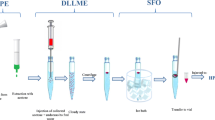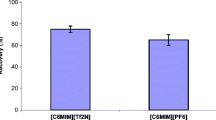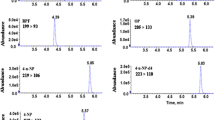Abstract
Bisphenol A (BPA) is a chemical widely used as a monomer in the production of polymers of plastics. It acts as an endocrine-disrupting agent and thus its contaminations of food and beverage should be carefully monitored in order to assess consumers’ risk. In this study, we propose a liquid chromatography-fluorescence detection (LC-FD)-validated method for the simultaneous determination of BPA and seven analogues, i.e., bisphenol AF, bisphenol B, bisphenol E, bisphenol F, BPA diglycidyl ether, bisphenol F diglycidyl ether, and Bisphenol M in soft drinks. A one-step solid-phase extraction (SPE) was effective at reducing the interferences, obtaining good purification of the samples, and consequently good recoveries of all analytes. The separation was obtained on a C18 column by using acetonitrile/water 55:45 (v/v) under isocratic conditions. Method validation was performed according to the European Commission Decision 2002/657/EC criteria, providing good results regarding the analytical parameters of linearity, selectivity, sensitivity, precision, recovery, decision limit (CCα), detection capability (CCβ), limit of detection (LOD), limit of quantification (LOQ), stability, and robustness. The method allows the detection of BPA and BADGE at levels much lower than their legal limits in the food, which are 0.06 and 9.00 mg kg−1, respectively.



Similar content being viewed by others
References
Alabi A, Caballero-Casero N, Rubio S (2014) Quick and simple sample treatment for multiresidue analysis of bisphenols, bisphenol diglycidyl ethers and their derivatives in canned food prior to liquid chromatography and fluorescence detection. J Chromatogr A 1336:23–33
Cao XL, Corriveau J, Popovic S (2009) Levels of bisphenol A in canned soft drink products in Canadian markets. J Agric Food Chem 57:1307–1311
Casajuana N, Lacorte S (2003) Presence and release of phthalic esters and other endocrine disrupting compounds in drinking water. Chromatographia 57:649–655
Casajuana N, Lacorte S (2004) New methodology for the determination of phthalate esters, bisphenol A, bisphenol A diglycidyl ether, and nonylphenol in commercial whole milk samples. J Agric Food Chem 52:3702–3707
Caserta D, Di Segni N, Mallozzi M, Giovanale V, Mantovani A, Marci R, Moscarini M (2014) Bisphenol A and the female reproductive tract: an overview of recent laboratory evidence and epidemiological studies. Reprod Biol Endocrinol 9:12–37
Cooper JE, Kendig EL, Belcher SM (2011) Assessment of bisphenol A released from reusable plastic, aluminium and stainless steel water bottles. Chemosphere 85:943–947
Cunha SC, Fernandes JO (2010) Quantification of free and total bisphenol A and bisphenol B in human urine by dispersive liquid-liquid microextraction (DLLME) and heart-cutting multidimensional gas chromatography-mass spectrometry (MD-GC/MS). Talanta 83:117–125
Cunha SC, Almeida C, Mendes E, Fernandes JO (2011) Simultaneous determination of bisphenol A and bisphenol B in beverages and powdered infant formula by dispersive liquid–liquid micro-extraction and heart-cutting multidimensional gas chromatography–mass spectrometry. Food Addit Contam 28:513–526
Deceuninck Y, Bichon E, Marchand P, Boquien CY, Legrand A, Boscher C, Antignac JP, Le Bizec B (2015) Determination of bisphenol A and related substitutes/analogues in human breast milk using gas chromatography-tandem mass spectrometry. Anal Bioanal Chem 407:2485–2497
European Commission Directive (2002a), 2002/16/EC of 20 February 2002 on the use of certain epoxy derivatives in materials and articles intended to come into contact with foodstuffs.
European Commission, Commission Decision (1895/2005) EC on the restriction of use of certain epoxy derivatives in materials and articles intended to come into contact with food
European Commission, Commission Decision (2002b), 2002/72/EC EC relating to plastic materials and articles intended to come into contact with foodstuffs.
European Commission Commission Decision (2002c), 2002/657/ EC implementing Council Directive 96/23/EC, Concerning the Performance of Analytical Methods and the Interpretation of Results.
Ferrer E, Santoni E, Vittori S, Font G, Mañes J, Sagratini G (2011) Simultaneous determination of bisphenol A, octylphenol, and nonylphenol by pressurised liquid extraction and liquid chromatography–tandem mass spectrometry in powdered milk and infant formulas. Food Chem 126:360–367
Fontana AR, Muñoz de Toro M, Altamirano JC (2011) One-step derivatization and preconcentration microextraction technique for determination of bisphenol A in beverage samples by gas chromatography-mass spectrometry. J Agric Food Chem 59:3559–3565
Fromme H, Küchler T, Otto T, Pilz K, Müller J, Wenzel A (2002) Occurrence of phthalates and bisphenol A and F in the environment. Water Res 36:1429–1438
Gallart Ayala H, Moyano E, Galceran MT (2010) Multiple-stage mass spectrometry analysis of bisphenol A diglycidyl ether, bisphenol F diglycidyl ether and their derivatives. Rapid Commun Mass Spectrom 24:3469–3477
Gallart-Ayala H, Moyano E, Galceran MT (2011) Analysis of bisphenols in soft drinks by on-line solid phase extraction fast liquid chromatography–tandem mass spectrometry. Anal Chim Acta 683:227–233
García-Arevalo M, Alonso-Magdalena P, Rebelo Dos Santos J, Quesada I, Carneiro EM, Nadal A (2014) Exposure to bisphenol-A during pregnancy partially mimics the effects of a high-fat diet altering glucose homeostasis and gene expression in adult male mice. PLoS One. doi:10.1371/journal.pone.0100214
Glausiusz J (2014) The plastics puzzle. Nature 508:306–308
Grumetto L, Montesano D, Seccia S, Albrizio S, Barbato F (2008) Determination of bisphenol A and bisphenol B residues in canned peeled tomatoes by reversed-phase liquid chromatography. J Agric Food Chem 56:10633–10637
Grumetto L, Gennari O, Montesano D, Ferracane R, Ritieni A, Albrizio S, Barbato F (2013) Determination of five bisphenols in commercial milk samples by liquid chromatography coupled to fluorescence detection. J Food Prot 76:1590–1596
Guart A, Bono-Blay F, Borrell A, Lacorte S (2011) Migration of plasticizers phthalates, bisphenol A and alkylphenols from plastic containers and evaluation of risk. Food Addit Contam 28:676–685
ILSI (2000) Packaging materials: polyethylene terephthalate (PET) for food packaging applications. International Life Sciences Institute (ILSI), Belgium
ISO 11843: (1997) Capability of detection — Part 1: Terms and definitions, Part 2: Methodology in the linear calibration case Part 2: methodology in the linear calibration case.
Jeng HA (2014) Exposure to endocrine disrupting chemicals and male reproductive health. Front Public Health. doi:10.3389/fpubh.2014.00055
Lassen TH, Frederiksen H, Jensen TK, Petersen JH, Joensen UN, Main KM, Skakkebaek NE, Juul A, Jørgensen N, Andersson AM (2014) Urinary bisphenol A levels in young men: association with reproductive hormones and semen quality. Environ Health Perspect 122:478–484
Le Corre L, Besnard P, Chagnon MC (2013) BPA, an energy balance disruptor. Crit Rev Food Sci Nutr. doi:10.1080/10408398.2012.678421
Leepipatpiboon N, Sae-Khow O, Jayanta S (2005) Simultaneous determination of bisphenol-A-diglycidyl ether, bisphenol-F-diglycidyl ether, and their derivatives in oil-in-water and aqueous-based canned foods by high-performance liquid chromatography with fluorescence detection. J Chromatogr A 1073:331–339
Li Y, Zhang S, Song C, You J (2013) Determination of bisphenol A and alkylphenols in soft drinks by high-performance liquid chromatography with fluorescence detection. Food Anal Methods 6:1284–1290
Liao C, Kannan K (2014) A survey of bisphenol A and other bisphenol analogues in foodstuffs from nine cities in China. Food Addit Contam Part A 31:319–329, Chemical Analytical Control Exposure Risk Assessment
Lintschinger J, Rauter W (2000) Simultaneous determination of bisphenol A-diglycidyl ether, bisphenol F-diglycidyl ether and their hydrolysis and chlorohydroxy derivatives in canned foods. Eur Food Res Technol 211:211–217
National Toxicology Program (2008) Chemical Information Profile for Bisphenol AF [CAS No. 1478-61-1]: Supporting Nomination for Toxicological Evaluation by the National Toxicology Program. http://ntp.niehs.nih.gov/ntp/htdocs/Chem_Background/ExSumPdf/BisphenolAF_093008_508.pdf.
North EJ, Halden RU (2013) Plastics and environmental health: the road ahead. Rev Environ Health 28:1–8
Olivieri A, Degenhardt OS, Mc Donald GR, Paulsen IM, Kozuska DN, Holt JL, Can A (2012) On the disruption of biochemical and biological assays by chemicals leaching from disposable laboratory plasticware. J Physiol Pharmacol 90:697–703
Rosenmai AK, Dybdahl M, Pedersen M, van Vugt-Lussenburg BMA, Wedebye EB, Taxvig C, Vinggaard AM (2014) Are structural analogues to bisphenol a safe alternatives? Toxicol Sci 139:35–47
Sajiki J, Miyamoto F, Fukata H, Mori C, Yonekubo J, Hayakawa K (2007) Bisphenol A (BPA) and its source in foods in Japanese markets. Food Addit Contam 24:103
Sendón Garcìa R, Paseiro Losada P (2004) Determination of bisphenol A diglycidyl ether and its hydrolysis and chlorohydroxy derivatives by liquid chromatography-mass spectrometry. J Chromatogr A 1032:37–43
Sungur S, Körolu M, Özkan A (2014) Determination of bisphenol A migrating from canned food and beverages in markets. Food Chem 142:87–91
Thomson BM, Grounds PR (2005) Bisphenol A in canned foods in New Zealand: an exposure assessment. Food Addit Contam 22:65–72
vom Saal FS, Hughes C (2005) An extensive new literature concerning low-dose effects of bisphenol A shows the need for a new risk assessment. Environ Health Perspect 113:926–933
Wang L, Zhang D, Xu X, Zhang L (2016) Application of ionic liquid-based dispersive liquid phase microextraction for highly sensitive simultaneous determination of three endocrine disrupting compounds in food packaging. Food Chem 197:754–760
Wua Y, Zhang Y, Zhang M, Liu F, Wana Y, Huang Z, Ye L, Zhou Q, Shi Y, Lu B (2014) Selective and simultaneous determination of trace bisphenol A and tebuconazole in vegetable and juice samples by membrane-based molecularly imprinted solid-phase extraction and HPLC. Food Chem 164:527–535
Xue J, Wu Q, Sakthivel S, Pavithran PV, Vasukutty JR, Kannan K (2015) Urinary levels of endocrine-disrupting chemicals, including bisphenols, bisphenol A diglycidyl ethers, benzophenones, parabens, and triclosan in obese and non-obese Indian children. Environ Res 137:120–128
Yang Y, Guan J, Yin J, Shao B, Li H (2014) Urinary levels of bisphenol analogues in residents living near a manufacturing plant in south China. Chemosphere 112:481–486
Zhao X, Fu X, Wang P, Li J, Hu X (2012) Determination of bisphenol diglycidyl ether residues in canned foodstuffs by high performance liquid chromatography—tandem mass spectrometry. Se Pu 30:1002–1007
Acknowledgments
This work was supported by the Italian Ministry of Health (RF-2009-1536185): “Food and environmental safety: the problem of the endocrine disruptors” coordinated by D.G. Mita).
Author information
Authors and Affiliations
Corresponding author
Ethics declarations
Conflict of Interest
The authors declare that they have no conflict of interest.
Human and Animal Rights
This article does not contain any studies with human or animal subjects.
Informed Consent
Not applicable.
Rights and permissions
About this article
Cite this article
Russo, G., Barbato, F. & Grumetto, L. Development and Validation of a LC-FD Method for the Simultaneous Determination of Eight Bisphenols in Soft Drinks. Food Anal. Methods 9, 2732–2740 (2016). https://doi.org/10.1007/s12161-016-0458-x
Received:
Accepted:
Published:
Issue Date:
DOI: https://doi.org/10.1007/s12161-016-0458-x




